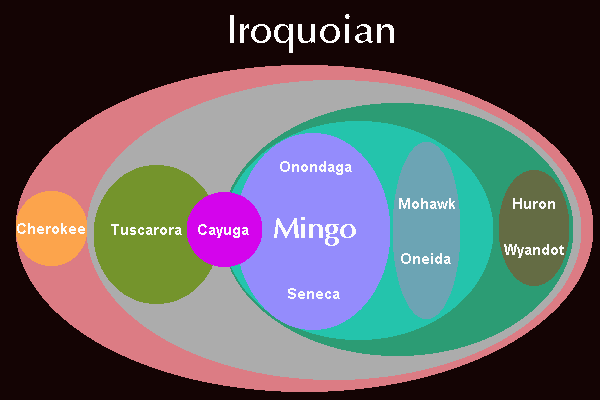Iroquoian Languages
West Virginia Mingo is a member of the Iroquoian family of languages.
On this page, we give some background on the languages of this family.
How many Iroquoian languages are there?
Although this seems like a simple question, it is actually trickier than
it appears. What counts as a separate language -- and what counts
as "just a dialect" of some language -- usually depends on a variety of
things, including historical, cultural, and geographic factors, as well
as actual differences in grammar, vocabulary and pronunciation. Depending
on how you weigh the different factors, cases could be made for as few
as 8 different Iroquoian languages, or as many as 16 or 17. From
my own perspective, I usually count 10 "main languages".
Cayuga
Cherokee
Huron
Mingo
Mohawk |
Oneida
Onondaga
Seneca
Tuscarora
Wyandot |
There are also a number of other Iroquoian languages that have been
extinct for over a century, and about which we know fairly little, including
Erie, Susquehannock and Laurentian.
Where are they spoken?
The Iroquoian languages were originally spoken over a very large expanse
of territory, including much of the southern Canada (Ontario and Quebec),
particularly along the St. Lawrence River and the Great Lakes, through
large portions of the Mid-Atlantic states, and down into the Carolinas.
Today, speakers of Iroquoian languages are still found in many of these
same areas, but the largest number of them are now in Oklahoma, among the
Cherokee. The table below gives a general indication of where each
of the languages is/was spoken.
Cayuga: central and western NY state, southern Ontario, northeastern
Oklahoma
Cherokee: western North Carolina and eastern Oklahoma
Huron: Ontario and Quebec
Mingo: eastern Ohio, western Pennsylvania, and West Virginia
Mohawk: northern New York, Ontario and Quebec |
Oneida: central New York, southern Ontario and eastern
Wisconsin
Onondaga: central New York
Seneca: western New York, southern Ontario, northeastern
Oklahoma
Tuscarora: North Carolina, western New York, southern Ontario
Wyandot: southern Ontario, northeastern Oklahoma |
How many people speak an Iroquoian language?
All of the Iroquoian languages today are endangered, to one degree or another,
and two of the ten languages above, Huron and Wyandot, are already extinct,
with no remaining native speakers. We can rank the remaining eight
in table below. Note that the number of speakers given here is only
a best-guesstimate, not an actual headcount.
| Language |
Speakers |
Cherokee
Mohawk
Oneida
Cayuga
Seneca
Onondaga
Tuscarora
Mingo |
22,000
2,500
300
300
100
80
under 5
under 5 |
How similar are the Iroquoian languages to one another?
The Iroquoian languages all bear a great deal of similarity to one another.
Indeed, it was not long ago that you could find many people who could speak
3, 4 or more of these languages with great fluency, due, in large part,
to how similar they are to one another. Mohawk speakers, for instance,
often report having little trouble understanding people speaking Oneida,
and vice-versa (this is one reason why some might want to consider Mohawk
and Oneida as dialects of the same language). The same often holds
true for speakers of Mingo, Cayuga and Seneca. Among the Northern
Iroquoian languages (that is, all of them except Cherokee), the main differences
lie in matters of pronunciation, and less so in vocabulary or grammatical
structure, so that if someone knows how to speak one of those languages,
they can acquire a working knowledge of one of the others with comparatively
little effort. On the other hand, Cherokee has more substantial differences
which set it apart from the Northern languages, and while its Iroquoian
nature clearly shows through under close inspection, the similarities are
much less obvious.
The diagram below gives a general indication of how the historical relationships
between the languages. Languages in the same small circle are closley
related to one another; languages in the same larger circle are less closely
related. Cayuga is a special case, as it appears to straddle the
boundaries between several of the other groups.

Are the Iroquoian languages related to any other languages?
This is still an open question, and one on which research continues to
this day. The language families which seem most likely to be related,
distantly, to the Iroquoian family are the Siouan family and the Caddoan
family. Most all of the languages in these families are spoken in
the Great Plains, stretching from the prairies of Canada down to the heart
of Dixie.
The languages of the Siouan family include:
Assiniboine, Biloxi, Catawba, Crow, Dakota, Hidatsa, Hocak (Winnebago),
Iowa-Otoe, Kansa, Lakhota, Mandan, Ofo, Omaha-Ponca, Osage, Quapaw, Stoney
and Tutelo.
The langauges of the Caddoan family include:
Arikara, Caddo Kitsai, Pawnee and Wichita.
The languages of the Algonquian family, which border Iroquoian-speaking
areas throughout much of the Northeast, are clearly not related to the
Iroquoian languages.
Back to the Mingo
Mainpage

